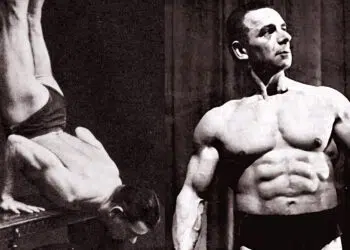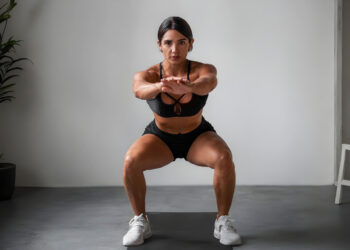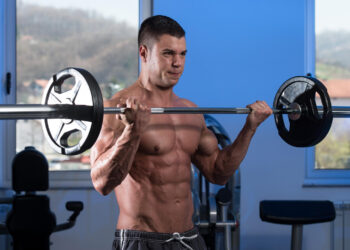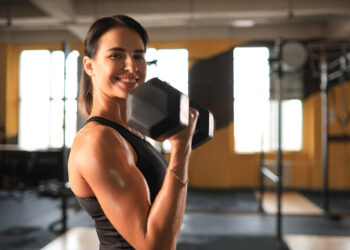As a veteran personal trainer with over 30 years of fitness industry experience, I’ve learned to love all forms of strength training. As such, I include bodyweight, machine, resistance band, and freeweights in my client’s workouts.
However, freeweights don’t just mean barbells and dumbbells; I’m also a big fan of kettlebells. While I’d never describe myself as a “kettlebell guy” and don’t use them all the time, I believe they are an incredibly versatile training tool.
I’ve found that kettlebells are a great way to build muscle size, strength, and power. In addition, studies suggest that kettlebell training can also improve aerobic and anaerobic endurance (1). To get started, check out our Essential Guide to Kettlebell Weights for tips on selecting the right kettlebells.
Many people limit themselves to just a couple of kettlebell exercises, usually swings and goblet squats. While these are very potent exercises, there are many more kettlebell movements you can use to reach your fitness and body composition goals.
In this article, I reveal my eight favorite lesser-known kettlebell exercises for full-body fitness.
8 Uncommon Kettlebell Exercises for Full-Body Fitness
Are you fed up with doing the same old kettlebell swings and goblet squats? While these are potent exercises, they will soon lose their appeal if you do them too often. The good news is that kettlebells are an incredibly versatile training tool, and there are lots of ways to use them.
Level Up Your Fitness: Join our 💪 strong community in Fitness Volt Newsletter. Get daily inspiration, expert-backed workouts, nutrition tips, the latest in strength sports, and the support you need to reach your goals. Subscribe for free!
Here are eight of my favorite lesser-known kettlebell exercises. Try them; I think you’ll like them!
1. Kettlebell Halos
Target muscles: Deltoids, rotator cuff, trapezius, rhomboids, core.
If you only pick up one new exercise from this article, I really hope it’s this one! The kettlebell halo is an excellent shoulder exercise that will build strength, mobility, and stability throughout your upper body.
Do it with light weights during your warm-up or with heavier weights as part of your main session. However and whenever you do it, this exercise will do your shoulders nothing but good.
How to do it:
- Stand with your feet roughly shoulder-width apart, knees slightly bent. Brace your core and hold your kettlebell in front of your chest so it’s upside down. Use the vertical handles, a.k.a. the horns.
- Raise one elbow and circle the kettlebell around your head. Take care not to hit yourself.
- Return the kettlebell to the starting position and then change directions.
- Alternate between clockwise and counterclockwise circles for the required number of reps.
Tips:
- Perform this movement smoothly and with control. Never rush your reps.
- The kettlebell should travel close to your head without coming into contact with it.
- Focus on leading with your elbow to maximize the effectiveness of this exercise.
2. Kettlebell Windmills
Target muscles: Deltoids, trapezius, rhomboids, rotator cuff, core, glutes, hamstrings.
Windmills are another kettlebell exercise that builds mobility, stability, and strength in equal measure. However, as well as working your upper body, you’ll also feel this exercise in your legs and core. Don’t go too heavy too soon with this exercise; if you lose control of the weight, you could injure your lower back, shoulder, or even your head!
How to do it:
- Hold the kettlebell in one hand overhead. Brace your core and engage your shoulders.
- Stand with your feet shoulder-width apart and toes turned out to around 45 degrees.
- Bend your knees slightly, but then keep them stationary during the movement.
- Looking up at the kettlebell, lean forward and reach down to touch the floor or your foot. Your arms should form one continuous line.
- Push down through your heels and midfoot while squeezing your glutes to return to the starting position.
- Continue for the desired number of reps and then switch sides.
Tips:
- Modify your range of movement according to your mobility and flexibility.
- Hold another kettlebell in your other hand for more of a challenge.
- You can also do this exercise in a half-kneeling position:
3. Bottoms-Up Kettlebell Press
Target muscles: Deltoids, trapezius, rhomboids, rotator cuff, triceps, forearms, core.
Overhead presses are arguably the most effective way to build bigger, stronger shoulders. However, barbell and dumbbell presses are hardly the most exciting exercises.
The bottoms-up kettlebell press is a very challenging shoulder exercise that will also improve your grip. Studies suggest that pressing kettlebells creates more tension in the anterior deltoids than conventional overhand presses (2). This is also an excellent shoulder rehab/prehab exercise.
How to do it:
- Stand with your feet shoulder-width apart, knees slightly bent, and core braced.
- Hold your kettlebell upside down in front of your shoulder. Your forearm should be vertical, and your elbow close to your body.
- Smoothly press the weight up and overhead to arm’s length.
- Lower it back to your shoulder and repeat.
- Switch arms and do the same number of reps on the other side.
Tips:
- Grip the handle tightly to stop the weight from tilting or tipping.
- Do this exercise in the half-kneeling position to stop you from using your legs.
- You can also do this exercise seated or with two kettlebells instead of one:
4. Two-Handed Kettlebell Straight Press
Target muscles: Deltoids, pectoralis major, trapezius, rhomboids, core, glutes.
Level Up Your Fitness: Join our 💪 strong community in Fitness Volt Newsletter. Get daily inspiration, expert-backed workouts, nutrition tips, the latest in strength sports, and the support you need to reach your goals. Subscribe for free!
The two-handed kettlebell straight press is a challenging upper-body exercise that you’ll also feel in your core and glutes. It’s essentially a kettlebell version of the Svend press. However, the spherical shape of the kettlebell means it feels quite different. Use this exercise as a finisher to your chest of shoulder workout.
How to do it:
- Stand with your feet shoulder-width apart, knees slightly bent, and core braced.
- Hold your kettlebell between your palms in front of your chest. Press your hands in and together.
- Maintaining the inward pressure, extend your arms in front of you while keeping your arms parallel to the floor.
- Bring the weight back to your chest and repeat.
Tips:
- Start with a light weight; this exercise is harder than it looks!
- You can also do this exercise while kneeling.
- Grip the handles instead of using the palms of your hands if you wish. However, this tends to reduce the tension in your pecs.
5. Bottoms-Up 90-Degree Kettlebell Carry
Target muscles: Deltoids, trapezius, rhomboids, triceps, forearms, core.
I’ve long been a fan of weighted carries. They’re a great way to build functional strength and muscle mass. In addition, weighted carries develop high levels of conditioning and determination. The bottoms-up 90-degree kettlebell carry is one of the most challenging weighted carries I know. However, it’s also one of the most rewarding!
How to do it:
- Holding your kettlebell upside down, raise the weight in front of you so your arm and shoulder are bent to 90 degrees. The kettlebell should be just above eye level.
- Brace your core and pull your shoulder down and back.
- Maintaining total body tension, go for a walk around your training area.
- Continue for the prescribed time or distance, or until your shoulder or grip fails.
- Switch sides and repeat.
Tips:
- Grip the handle tightly to stop the weight from tilting or tipping.
- Hold your kettlebell closer to your body to make this exercise easier.
- You can also do this exercise with two kettlebells.
6. Kettlebell Push-Up & Renegade Row
Target muscles: Pectoralis major, deltoids, latissimus dorsi, trapezius, rhomboids, biceps, triceps, forearms.
Lack of time is a common barrier to consistent training. It’s also arguably one of the most difficult to overcome. After all, it’s hard to make more time when you are busy. The good news is that even a few minutes of exercise will do you good. The kettlebell push-up and renegade row works every upper body muscle, so it’s ideal for time-pressed exercisers.
How to do it:
- Place your kettlebells on the floor about shoulder-width apart. The handles should be parallel.
- Squat down, grip the handles, and walk your feet out and back into the push-up position. Brace your core to stabilize your spine.
- Keeping your body straight, bend your arms and lower your chest between your hands.
- Extend your arms and then row each kettlebell into your lower abdomen.
- Repeat the push-up/row/row sequence for the required number of reps.
Tips:
- Grip the handles tightly to stop the weights from tipping.
- Make this exercise easier by bending your legs and resting on your knees.
- No kettlebells? No problem! You can also do this exercise with dumbbells.
7. Kettlebell Hammer Curls
Target muscles: Biceps, brachialis, brachioradialis, core.
Most kettlebell exercises are either compound or full-body. That’s good news because those types of exercise are the best way to build functional strength and conditioning. However, you can also use kettlebells to sculpt more muscular arms and a powerful grip. Kettlebell hammer curls are one of the best arm exercises I know.
How to do it:
- Hold a kettlebell in each hand with your arms by your sides. Stand with your feet about shoulder-width apart, knees slightly bent, and core braced. Pull your shoulders down and back.
- Without using your legs or back to lift the weight, bend your arms and raise the weights to about shoulder height. Note how the muscle tension increases as you lift the kettlebells.
- Lower the kettlebells back to your sides and repeat.
Tips:
- Grip the handles tightly to keep the weights stable and maximize muscle engagement.
- You can also do this exercise with one kettlebell or using an alternating arm action.
- Don’t go too heavy too soon; the extended levers mean this exercise is much more challenging than it first appears.
8. Turkish Get-Ups
Target muscles: Deltoids, trapezius, rhomboids, triceps, core, forearms, gluteus maximus, hamstrings, quadriceps.
Kettlebell exercises don’t come much more unusual than the Turkish get-up. While the origins of the name are shrouded in mystery, this complex movement develops full body strength, mobility, and stability. Pair it with the kettlebell push-up/renegade row for a total body workout in 15 minutes or less.
How to do it:
- Lie on your back with your legs straight and together. Hold a single kettlebell at arm’s length over your chest. Look up at the weight and keep your eyes fixed on it through the whole exercise.
- Bend your leg and place your foot flat on the floor. If you are holding the weight in your left hand, bend your left leg. If you’re using your right arm, bend your right leg. Extend your opposite arm to the side at 90 degrees to your body.
- Brace your core and drive your foot into the floor. Sit partway up and press the weight up to the ceiling. Simultaneously, roll across onto the opposite forearm while keeping your load-bearing arm vertical.
- Push your forearm away from the floor so your supporting arm is straight.
- Lift your hips off the floor so you are in a side plank. Keep your uppermost arm straight and your eyes fixed on the weight.
- With your hips raised, bring your straight leg under you and into a half-kneeling position. Push off the floor with your hand and move your torso into an upright position.
- From here, stand up so that your feet are together. Your weight-bearing arm should be vertical.
- Return to the starting position by doing the same movement in reverse.
Tips:
- Beginners should learn this exercise without weight. Only use a kettlebell once you have mastered the movement.
- Keep your reps low to preserve movement quality. 3-5 per side works well.
- You can also do this exercise using a squat technique:
Closing Thoughts
Kettlebells are a valuable, versatile training tool. You can use them to achieve almost any fitness goal. They’re ideal for home workouts, as they’re simple, robust, and will last a lifetime. All you need is a couple of different weights, and you’ll have access to an entire library of kettlebell exercises.
So, don’t limit your workouts to just a few kettlebell staples. While there is nothing wrong with the old standards, like swings and goblet squats, there are plenty of other exercises you can do to keep your workouts fresh and interesting.
Use this guide to learn eight new kettlebell exercises. They’re some of my favorites, and once you try them, I reckon they’ll become your favorites, too.
References:
- Vancini RL, Andrade MS, Rufo-Tavares W, Zimerer C, Nikolaidis PT, de Lira CAB. Kettlebell Exercise as an Alternative to Improve Aerobic Power and Muscle Strength. J Hum Kinet. 2019 Mar 27;66:5-6. doi: 10.2478/hukin-2018-0062. PMID: 30988835; PMCID: PMC6458586.
- Błażkiewicz M, Hadamus A. The Effect of the Weight and Type of Equipment on Shoulder and Back Muscle Activity in Surface Electromyography during the Overhead Press-Preliminary Report. Sensors (Basel). 2022 Dec 13;22(24):9762. doi: 10.3390/s22249762. PMID: 36560129; PMCID: PMC9781216.
Article Updates Timeline:
Our editorial team experts constantly update the articles with new information & research, ensuring you always have access to the latest and most reliable information.
January 18, 2024
Written By
Patrick Dale, PT, ex-Marine
Edited By
Editorial Team








